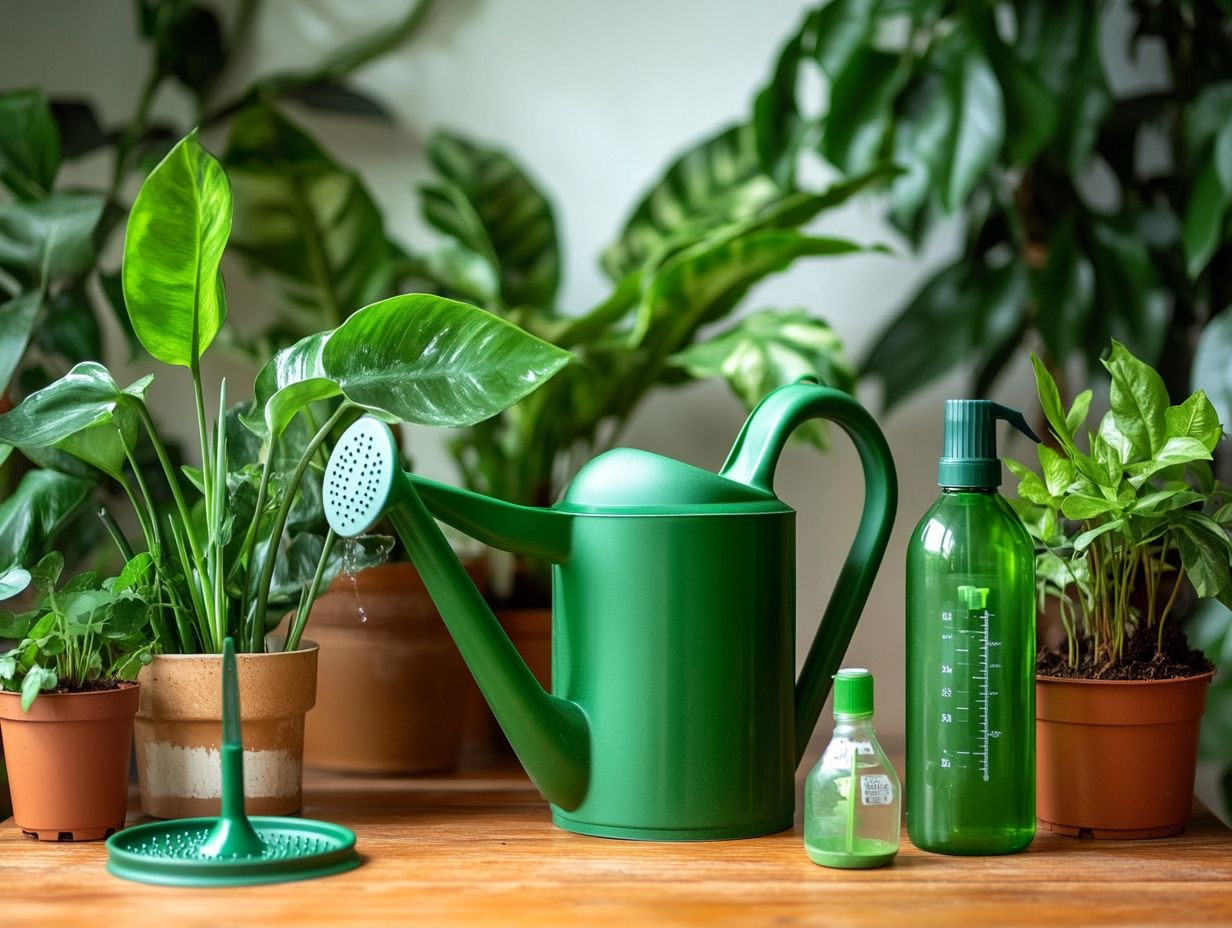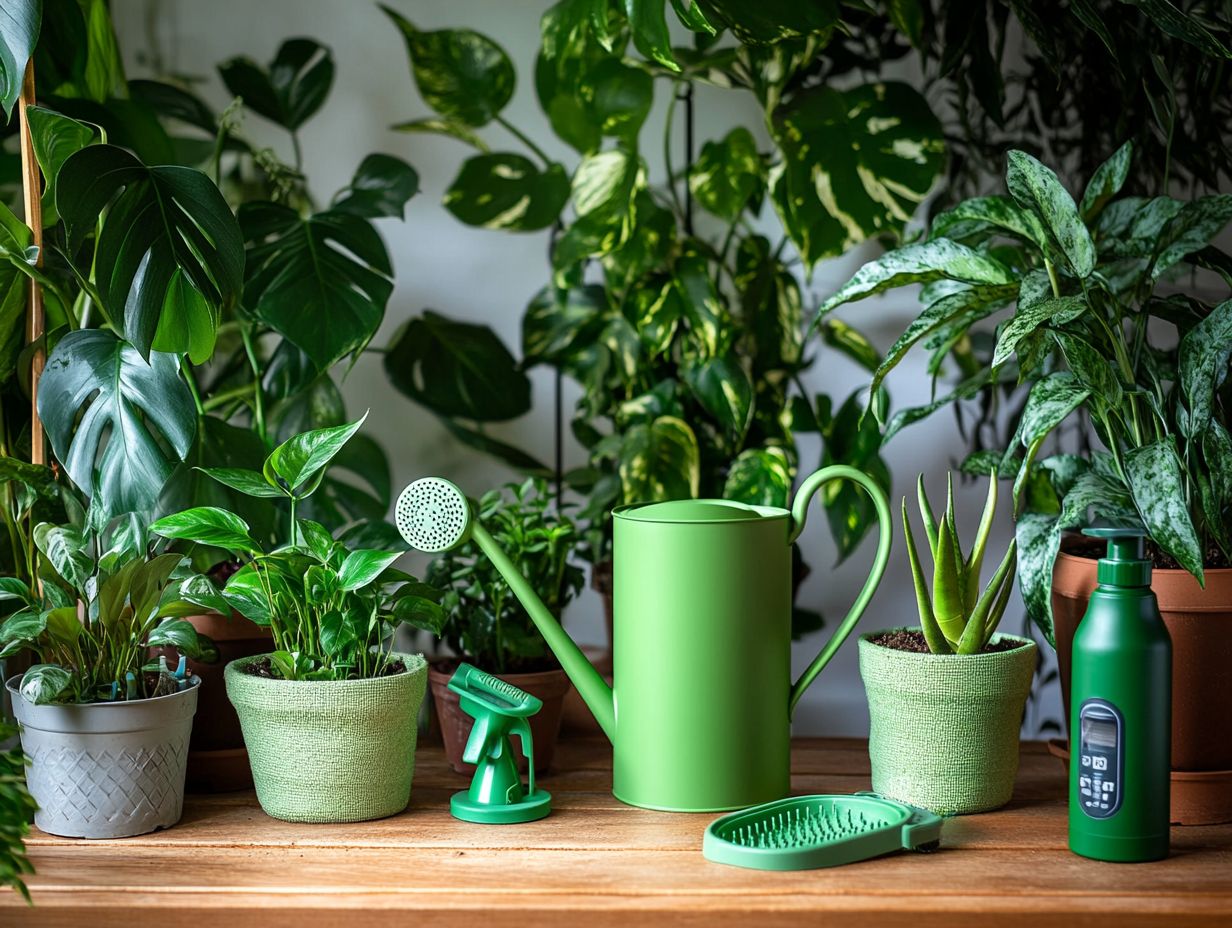5 Eco-Friendly Cities to Visit in North America
Keeping your indoor plants healthy and thriving demands more than just the right amount of sunlight. Proper watering is crucial.
Discover five essential tools that will simplify your indoor plant watering routine. These range from classic watering cans to innovative self-watering pots!
Understand how often you should water your plants. Learn about the factors that influence watering frequency and the signs of overwatering or underwatering.
Get expert tips on crafting a watering schedule tailored to your lifestyle. Practical advice will elevate your indoor garden to new heights!
Contents
- Key Takeaways:
- 1. Watering Can
- 2. Self-Watering Pots
- 3. Drip Irrigation System
- 4. Watering Spikes
- 5. Spray Bottle
- How Often Should Indoor Plants Be Watered?
- What Factors Affect the Frequency of Watering Indoor Plants?
- What Are the Signs of Overwatering and Underwatering?
- What Are the Different Types of Watering Cans and Their Uses?
- How Do Self-Watering Pots Work and Are They Effective?
- What Are the Benefits of Using a Drip System for Indoor Plants?
- How Do Watering Spikes Work and Are They Suitable for All Plants?
- What Are the Advantages of Using a Spray Bottle for Watering Indoor Plants?
- How Can One Create a Watering Schedule for Their Indoor Plants?
- What Are Some Tips for Proper Indoor Plant Watering?
- Frequently Asked Questions
- What are the 5 essential tools for indoor plant watering?
- Why do I need a watering can for indoor plants?
- Can I use a regular spray bottle for watering indoor plants?
- What is a watering globe and why is it important for indoor plant watering?
- Why should I invest in a moisture meter for my indoor plants?
- Do I really need a watering hose for my indoor plants?
Key Takeaways:

- Choose the right tools for indoor plant watering, including watering cans, self-watering pots, drip irrigation systems, watering spikes, and spray bottles.
- Proper watering is crucial for healthy indoor plants. Factors like plant type, environment, and season affect how often you should water.
- Watch for signs of overwatering and underwatering such as wilting, yellowing leaves, and root rot. Create a flexible watering schedule, adjusting as needed!
1. Watering Can
The watering can is an essential tool in your gardening kit. It makes watering your indoor plants efficient and effective.
This ensures optimal moisture control and overall plant health. Follow best practices for maintaining hydration in plants, from tropical beauties to air-purifying wonders!
There are many styles available, from charming metal designs to sleek plastic options. Choosing the right watering can depends on your personal preferences and the needs of your plants.
Consider factors like size, spout length, and weight. A long spout can reach deep into larger pots, while a lighter can is easier to handle.
Establishing a thoughtful watering routine is essential. Aim to use room-temperature water to avoid shocking your plants.
Don t overlook the importance of adequate drainage holes. This is crucial for preventing root rot.
Consider using moisture meters for valuable insights into soil health. They will guide your watering decisions and help you grow lush, thriving greenery!
2. Self-Watering Pots
Self-watering pots are your ultimate allies in plant care. They revolutionize how you maintain your indoor garden!
These pots automate the watering process, ensuring your soil stays healthy and moisture levels are just right. Say goodbye to the worry of overwatering while ensuring your beloved philodendrons and Spider Plants get the hydration they crave.
These clever pots work through a water storage system that lets your plants absorb water gradually through the way plants absorb water. This promotes robust root development.
This technique is especially advantageous for a variety of houseplants, catering to their specific moisture needs and alleviating the stress that comes with erratic watering.
When compared to traditional methods, self-watering pots provide a more relaxed approach to plant care. They offer you greater flexibility!
To maximize their effectiveness, it s essential to select the right soil types those that retain moisture while allowing for proper drainage. Plus, adding grow lights can supercharge your plants growth by ensuring they get enough light, especially in low-light conditions!
3. Drip Irrigation System
A drip irrigation system is the pinnacle of efficient watering, delivering precise amounts of water directly to the area around the roots where plants absorb water and nutrients. This method minimizes water waste while optimizing humidity levels. It s the perfect choice for anyone who takes pride in cultivating a vibrant indoor garden, especially as the seasons change.
This innovative system comprises a network of tubes and emitters. You can easily customize these to cater to the specific water needs of various plant types. By understanding the unique requirements of each species, you can design a layout that promotes growth while significantly reducing the risk of overwatering a common misstep for many new gardeners.
With a drip system, you enjoy the luxury of consistent moisture levels, which is vital for maintaining optimal plant health. Regularly monitoring the output and making necessary adjustments is crucial to prevent clogs. This ensures that each plant gets its fair share, preserving the vitality of your indoor oasis.
4. Watering Spikes
Watering spikes offer a sophisticated solution for maintaining moisture control in your indoor plants. They allow you to establish a consistent watering routine that minimizes the risk of overwatering. This is especially advantageous if you travel frequently or struggle with common plant care mistakes.
These clever devices work by gradually releasing water from a reservoir into the soil. This ensures your plants receive a steady supply of moisture without the threat of waterlogging. They cater to a variety of plant types, from delicate houseplants that thrive on consistent humidity to robust varieties that flourish with regular hydration.
When you install these spikes, make sure to position them correctly in well-draining containers to maximize their efficiency. Using the technique of bottom watering enhances plant health, allowing roots to absorb moisture as needed and creating a harmonious balance in your indoor garden setup.
5. Spray Bottle

A spray bottle is an essential tool that can transform your indoor gardening experience! It helps maintain ideal humidity levels for your air-purifying and tropical plants. It provides a gentle way to hydrate foliage while warding off plant diseases that can arise from excessive dryness.
This versatile tool also assists in pest control. A fine mist can easily dislodge pests from leaves, allowing you to manage infestations without harsh chemicals. If you’re nurturing ferns or orchids, regular misting mimics their natural humid habitats, which is essential for their growth and survival.
To make the most of your spraying routine, aim for the early morning or late afternoon. This timing helps prevent leaf burn from direct sunlight. Consider using distilled water, as it can help prevent mineral buildup, ensuring your plants receive the cleanest nourishment possible.
With the right spray bottle in hand, you can significantly enhance the health and vigor of your beloved plant collection.
How Often Should Indoor Plants Be Watered?
Determining how often you should water your indoor plants involves several key factors, including the type of plant, the season, and the surrounding environmental conditions. It s essential for you to develop a personalized watering routine that supports robust plant health and optimizes seasonal growth while steering clear of common pitfalls like overwatering or underwatering.
Soil types are particularly significant for moisture retention. Sandy soils drain quickly and will require more frequent watering, whereas clay soils can hold moisture longer. Additionally, ambient temperature and humidity levels directly influence your plants water needs warmer, drier conditions call for increased watering frequency.
Understanding the specific requirements of your various plant varieties helps you refine your watering schedule. This allows you to adjust based on their unique nutrient uptake. By observing changes in leaf health and checking soil moisture, you can tailor your approach, ensuring each plant thrives with just the right amount of hydration at the right time. Your plants health depends on it!
What Factors Affect the Frequency of Watering Indoor Plants?
Several factors influence how often you should water your indoor plants, including soil health, temperature regulation, and humidity levels. These elements play a significant role in determining how much water each plant needs to flourish in its unique environment.
Understanding these factors is essential for anyone eager to maintain a vibrant indoor garden. For example, well-aerated soil promotes better drainage. It is vital to choose the right mix to prevent root rot, especially for moisture-sensitive varieties like succulents.
In warmer rooms, evaporation rates tend to rise. This means you’ll need to water thirsty plants like ferns or peace lilies more frequently, as they thrive in humid conditions. Using a hygrometer to monitor humidity levels can be a great strategy to ensure that your moisture-loving plants get just the right amount of water.
Don t forget to adjust your watering routines based on seasonal changes. During winter, many plants enter dormancy and require significantly less water. This allows them to conserve energy and thrive come spring.
What Are the Signs of Overwatering and Underwatering?
Recognizing the signs of overwatering and underwatering is essential for maintaining the health of your indoor plants. Both conditions can lead to plant diseases and a decline in overall health, often arising from common mistakes made by inexperienced gardeners, especially regarding watering techniques.
Understanding the specific symptoms of these watering issues gives you the power to intervene promptly. Overwatered plants may show yellowing leaves, particularly the older ones. They may also appear limp and take on a mushy texture a clear sign of root rot. In contrast, underwatered plants often exhibit signs of dehydration, such as crispy, browning leaf edges, and curling leaves.
To prevent these issues, it’s crucial to regularly assess your plants needs by observing the soil moisture levels and adjusting your watering schedule accordingly. If problems do arise, simple corrective actions can make a significant difference: allow the soil to dry out for overwatered plants or give underwatered ones a thorough soak to restore their vitality.
What Are the Different Types of Watering Cans and Their Uses?
There are various types of watering cans designed for different uses in indoor gardening, each serving specific purposes to enhance your plant care and facilitate effective watering techniques tailored to a wide range of indoor plants.
A watering can with a long spout can be particularly advantageous for narrow spaces or delicate plants, allowing you to precisely direct water where it’s needed most. Conversely, larger cans can hold more water, making them ideal for bulk watering of expansive indoor gardens or groups of potted plants.
When selecting the perfect watering can, it is crucial to consider not just the size and shape but also the specific needs of your plants. Succulents, for example, require less frequent watering and benefit from a can that allows for a light touch of moisture, whereas leafy plants may thrive on a more generous supply. Understanding these distinctions helps you ensure optimal hydration, promoting healthy growth and vibrant greenery.
How Do Self-Watering Pots Work and Are They Effective?
Self-watering pots feature an ingenious design that allows your plants to absorb water at their own pace. This ensures optimal moisture control while minimizing the risk of overwatering, thanks to strategically placed drainage holes.
The system typically includes a reservoir at the bottom, where excess water is stored and gradually drawn upward through capillary action, which is the way water moves through the soil. This clever feature not only keeps the roots consistently nourished but also fosters healthier growth by providing a more stable environment compared to traditional pots.
For indoor plants such as succulents and ferns, this method takes the stress out of watering, resulting in vibrant foliage and robust roots. With self-watering pots, you can easily maintain your greenery without the frequent monitoring that conventional methods demand, making them a smart choice for anyone eager to elevate their indoor gardening experience.
Act fast to check your plants’ moisture levels!
Start your indoor gardening journey today with the right tools!
What Are the Benefits of Using a Drip System for Indoor Plants?
Using a drip system for your indoor plants comes with a wealth of benefits. Imagine having healthier plants and saving time while watering! You gain precise moisture control. This reduces water waste and enhances convenience, all of which lead to healthier plants and more efficient watering techniques.
This innovative method lets you customize your watering schedule to meet the specific needs of your diverse plant types. By ensuring moisture levels remain consistent, you avoid the pitfalls of overwatering or neglecting any particular species. With water delivered directly to the roots, you significantly minimize the risk of leaf diseases that can harm your plants.
The ease of use far surpasses traditional methods. With just a simple timer or even a smartphone app, you can effortlessly adjust settings for different plants, making it perfect for your busy lifestyle. Ultimately, a drip system nurtures a thriving indoor garden, promoting strong root development and optimizing nutrient absorption.
How Do Watering Spikes Work and Are They Suitable for All Plants?
Watering spikes work by gradually releasing water into the soil, offering you an effective way to manage moisture levels. This can be particularly advantageous for various indoor plants, although it s worth noting that not all plant varieties will benefit due to their differing watering requirements.
Typically crafted from ceramic or plastic, these spikes are designed to maintain a steady water supply, helping you avoid the risks of overwatering while encouraging healthy root growth. One of the standout benefits is the convenience they provide ideal for saving you time and effort, especially during those well-deserved vacations. Be aware of their limitations; not every plant thrives with consistent moisture. Most succulents thrive in drier conditions.
To get the most out of watering spikes, consider using them with plants that appreciate higher humidity, such as ferns and tropical varieties. Common pitfalls include over-filling the spikes or placing them too shallowly in the soil, which can hinder effective water delivery and result in uneven hydration.
What Are the Advantages of Using a Spray Bottle for Watering Indoor Plants?
Using a spray bottle for watering your indoor plants comes with a host of advantages. It allows you to quickly boost humidity levels, provide targeted moisture, and care for delicate air-purifying plants without the risk of overwatering.
This tool proves invaluable in minimizing water wastage, ensuring that moisture reaches the root systems directly instead of saturating the surrounding soil. It’s versatile, catering to various plant types, particularly those needing specific humidity levels, like ferns or orchids. Plus, a spray bottle can serve as a preventative measure against pests, making it effortless to apply natural insecticidal solutions. For more effective methods, consider the best watering techniques for indoor plants.
Don’t miss the chance to create a thriving indoor garden with just a spray bottle! To reap the full benefits, position the sprayer about 6 inches from the plant and spray in the morning. This approach promotes moisture absorption during peak light hours, keeping your plants thriving.
How Can One Create a Watering Schedule for Their Indoor Plants?
Creating a watering schedule for your indoor plants is essential for achieving optimal growth and health. This structured approach allows you to systematically monitor your plants’ needs and adjust your routine based on seasonal changes and the specific varieties you have.
By establishing a clear timetable, you can ensure that each plant receives the right amount of water during various growth stages. It’s crucial to consider the unique requirements of different plant types some thrive in drier conditions, while others prefer their soil consistently moist. Factors like soil composition whether sandy, clayey, or loamy play a significant role in how quickly water is absorbed and retained.
Utilizing moisture meters or simple finger tests to assess soil dampness, along with being attentive to seasonal variations, enables you to fine-tune your watering frequency. This approach promotes vigorous growth and prevents root rot.
What Are Some Tips for Proper Indoor Plant Watering?

Proper indoor plant watering is essential for maintaining the health of your greenery. You can easily achieve this by following best practices that help you avoid common pitfalls like overwatering or underwatering.
To effectively manage this vital aspect of plant care, remember that different plants need different amounts of water. Understanding the science of watering indoor plants and checking the soil moisture before watering can make a big difference!
Establishing a consistent watering routine trains you and helps your plants thrive. Consider factors such as the amount of natural light your plants receive and the ambient temperature around them. For instance, a plant soaking in bright light will likely need more water than one in a shadier corner.
Keep these tips in mind to create a vibrant indoor garden today!
Frequently Asked Questions
What are the 5 essential tools for indoor plant watering?
The 5 essential tools for indoor plant watering are a watering can, a spray bottle, a watering globe, a moisture meter, and a watering hose.
Why do I need a watering can for indoor plants?
A watering can allows you to control how much water you give to each plant, preventing over or under watering. It also helps avoid mess while watering.
Can I use a regular spray bottle for watering indoor plants?
Yes! A spray bottle is great for small indoor plants that don t need much water. It s also useful for misting plants that thrive in high humidity.
What is a watering globe and why is it important for indoor plant watering?
A watering globe is a glass bulb with a long stem that holds water. It slowly releases water to the plant, ensuring consistent moisture levels. It’s perfect for busy individuals who may not have time to water regularly.
Why should I invest in a moisture meter for my indoor plants?
A moisture meter is a valuable tool that tells you how wet the soil is. This helps you avoid over or under watering, supporting optimal soil health.
Do I really need a watering hose for my indoor plants?
A watering hose isn’t necessary for indoor plants, but it can be helpful for larger plants or multiple plants in one area. It allows you to reach further and water more efficiently without constantly refilling a watering can.







